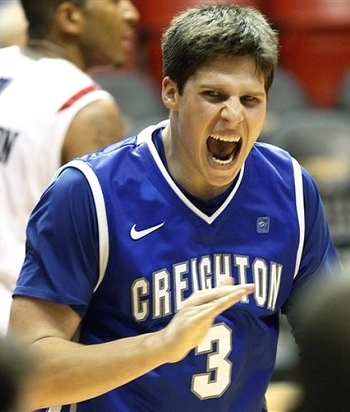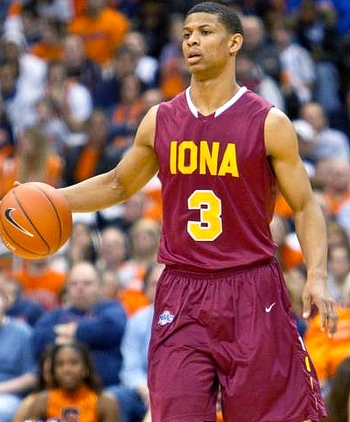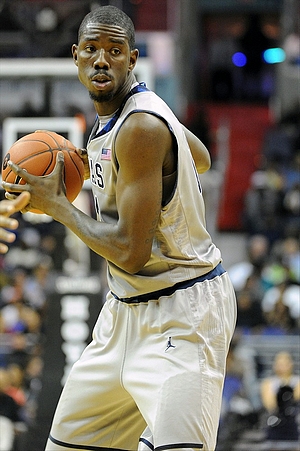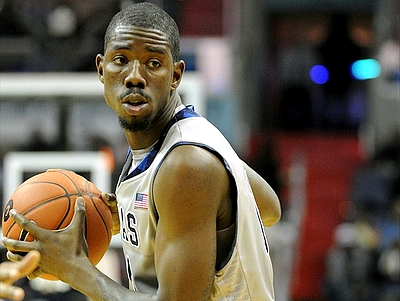DX NBA Draft Prospect of the Week: Cody Zeller
Doug McDermott, 6-7, Sophomore, SF/PF, Creighton

Derek Bodner
After rumors that he would be redshirted his freshman year at Creighton, Doug McDermott exploded. The 6'7 forward averaged an efficient 15 points per game in route to earning the Missouri Valley Conference freshman of the year award, as well as being the first freshman in over 50 years to earn first team All-MVC honors.
Standing 6-7 and weighing a slight 210 pounds, McDermott plays primarily the power forward spot for Creighton. Despite his slender build, McDermott has expanded his post game to become an inside-outside threat. Through the early parts of the season, McDermott has shouldered an increased scoring load, seeing his scoring average increase from 20.5 points per 40 minutes to 33.4, which ranks #1 in our database thus far. He has been doing so at an astounding 71% true shooting percentage, a number that is unsustainable once his team starts playing actual competition, but provides a glimpse of the skill-level he possesses and the matchup problem he has become for defenders.
Operating from the post with more frequency -- his post game now comprises 39% of his half-court offense according to Synergy Sports Technology -- McDermott does a good job of working for position. While not very explosive vertically, he also does a nice job shielding the ball from defenders and going up quickly, catching defenders off guard and allowing him to get the ball up despite his size. He's showing an increasingly diversified set of counter moves with improved footwork, and has been doing a better job of recognizing the increasing amount of double teams he receives.
On the perimeter, McDermott is largely a catch and shoot player, rarely creating either for himself or for others off the dribble, and his ball handling and shot creating ability are clear weaknesses for a player who doesn't have the physical strength or length to play in the post at the next level. He does show excellent form on his jump shots, with a quick and high release that shows remarkable consistency. According to Synergy Sports Technology, he is shooting an incredible 1.826 points per possession on jump shot attempts so far this season, a number that once again will be virtually impossible to sustain, but is extremely impressive nonetheless.
Considering he shot 57% inside the arc and 40.5% from beyond the arc last season, this is obviously not just a fluke, and it appears he's improved even more this summer, making him one of the most potent scorers in the country.
McDermott also excels playing off the ball, giving consistent effort both on cuts to the basket and on offensive rebounds. The quickness he is able to get shots up around the rim once again aids him in scoring in the paint despite his slender build and below the rim game. He is also a weapon in transition, as he gets out early on the break and, while not being an exceptional overall athlete, is fairly quick running the floor.
One of the primary things that stand out, both when watching him play and when looking at stat sheet, is that McDermott does not get to the free throw line very often, as his 4.2 free throw attempts per 40 minutes ranks just average amongst power forward prospects. Part of this is due to style. His quick release and ability to shield the ball from defenders allows him to convert in the paint despite physical limitations, but it also limits his ability to get to the line. As he goes up against longer and more physical competition he'll need to improve his ability to get to draw fouls to maintain his terrific efficiency.
The defensive side of the ball looks to be the primary issue with McDermott when projecting his chances at the next level. His effort level appears to be adequate, but his physical limitations are evident. He doesn't have the size or strength to deny position in the post, and he doesn't have either the length or quickness off the floor to provide much if any weak-side help. On the perimeter, which is where he is more likely to play at the next level, his lateral quickness is a huge concern. He tends to give a large amount of space on the perimeter to combat his mediocre foot speed, both when defending isolation and pick and roll sets, a problem that is sure to become more pronounced the more he is asked to defend away from the basket.
McDermott does a solid job on the glass, as both his 3.8 and 8.8 offensive and defensive rebounds per 40 minutes are very good for a power forward. He once again overcomes his lack of size and explosiveness with good instincts on the glass and a very good effort level.
The son of Creighton head coach Greg McDermott, Doug McDermott plays the role of a coach's son. His excellent feel for the game and consistently high effort level allow him to maximize his physical attributes, qualities that are valuable when projecting a potential change in role from focal point of a team to role player at the next level. His excellent catch and shoot ability forms the basis of a good skill set for a role player, but he'll likely have to improve his defense considerably if he hopes to successfully make the transition to the NBA.
Scott Machado, 6-1, Point Guard, Senior, Iona

Walker Beeken
After finishing second in the nation in assists per game in 2010-2011, Iona's Scott Machado still entered his senior season as a player under the national radar. Through only seven games this season, however, Machado has changed that in a big way, catching the attention of NBA scouts with some big outings against the likes of Purdue, Maryland and St. Joe's.
Machado spent the summer representing Brazil at the World University Games, and has entered this season with an improved conditioning level and leaner physique, giving him a quicker burst with the ball in hands, and the ability run Iona's up-tempo offense for over 36 minutes per game so far this season.
Standing 6'1 with a strong, sturdily built frame, Machado isn't a top notch athlete at the point guard position by NBA standards, but he does appear to have the physical tools to be able to compete on both ends of the floor as long as he maintains his conditioning level.
On the offensive end, Machado does much of his damage in transition, leading Iona's high-octane attack and showing excellent court vision leading the break with the ability to thread the needle to a teammate running the floor or find an open shooter at the 3-point line. He has a great command of the ball and moves very fluidly and confidently with the dribble with a nice top speed, while also having a knack for making difficult passes look easy.
In the half-court, Machado is less dynamic, but is still very effective thanks to the extra burst he has this season, which enables him to get into the paint more frequently off the bounce. He shows excellent passing instincts when attacking the basket, whether it be dump-offs to cutters for layups or kick-outs to open shooters. His lack of size and vertical explosiveness hurts him an a finisher, however, and would likely be a bigger issue in the NBA with the longer, more athletic players he'd face once he entered the paint.
Machado has also shot the ball much better this season, albeit in a very small sample size, improving his percentages on 2-pointers, 3-pointers, and from the free throw. His solid early season 39% from behind the 3-point arc will bode well for him if he can sustain it for the remainder of the season. He certainly shoots the ball like he thinks he's a shooter, confidently spotting up and pulling up from well behind the NBA 3-point line on occasion without any hesitation. He has a decent stroke and fluidly shoots the ball off the dribble, but he could probably stand to be a bit more selective with when to fire away from deep.
Defensively is where scouts will likely have their biggest questions marks with Machado. Iona mixes up its defenses quite a bit, with some pressing and some zone, so Machado hasn't had to play as much half-court man-to-man. In what we could see, however, he looks like he has some work to do to defend point guards at the NBA level. His lateral quickness looks mediocre, he's a bit on the smaller side, and he's been beaten off the dribble badly on a few occasions and also has done a poor job fighting through screens. Some of this could be correctable and some could be a result of the system he's in, but this will likely be an area that NBA teams will want to get a better gauge of as they assess his potential at the next level.
Machado will likely continue to pile up big assists numbers throughout the MAAC schedule while having a chance at winning Conference Player of the Year Honors. From an NBA scouting perspective, though, it may be tough to get a great read on just how well his game might translate to the NBA level, with his team's frenetic pace and the lower level of competition which they'll face the majority of the season.
Helping his talented Iona squad win their conference tournament and earning a NCAA berth would surely help in this regard.
He's already made a great early season impression, though, and earned plenty of fans who will want to monitor him throughout the season, particularly early next month at Madison Square Garden where his team faces Siena as part of a double-header prior to Louisville-St. John's.
Point guards with Machado's court vision and passing instincts are always coveted by NBA teams, and there should be plenty lining up to eventually get a closer look at him in the pre-draft processfor example the PIT--where they'll get a better chance to see how he stacks up against some of the other top prospects at the point guard position.
Henry Sims, 6-10, Center, Senior, Georgetown

Joe Treutlein
Henry Sims has had a long and slow journey to the national scene in his four years at Georgetown, slowly earning more minutes and improving his numbers each season, and is now showing some consistent flashes that deserve attention given his physical tools.
Despite being fairly highly regarded coming out of high school (#34 Scout.com, #49 Rivals), Sims didn't see much playing time in his first two seasons at Georgetown, and only averaged 14 minutes per game as a junior.
Standing 6'10 with a well-built, broad-shouldered upper body and an adequate lower body, Henry Sims is a decent athlete for his size, excelling more with mobility and coordination than explosiveness or quickness, but doesn't run the floor particularly well. He has good length, and despite his already solid overall bulk, he probably could still add some more, specifically in his lower body.
On the offensive end, Sims shows intriguing flashes in a variety of areas, though he hasn't really mastered any individual aspect of his game. He sees most of his touches operating in the low post at this stage, where he has a solid mix of finesse moves, but still is a little rough around the edges.
From the low block, Sims relies on an assortment of drop-steps, hook shots, and turnaround jumpers, showing the ability to turn off either shoulder and finish with either hand, though his touch isn't great with either. He has a strong tendency to extend his drop-steps under the rim, where he likes finishing with reverse lay-ups, doing a good job utilizing his length to create separation. Sims struggles operating through contact and doesn't really have a go-to move at this stage, showing inconsistent results with all aspects of his finesse game, and it's not likely teams at the next level would look for him to create his own offense in the post.
Sims' perimeter game isn't utilized as frequently, but could be more useful to him in the long-term, and he shows some excellent flashes already both with his dribble-drive and perimeter jumper. Sims does a good job putting the ball on the floor and driving to the rim both from the perimeter and turning into his opponent in the mid and high post, showing rangy strides and a decently controlled dribble for a player his size.
He will occasionally shift the ball between hands or make a subtle change of direction to get an angle on a defender, but primarily only operates on straight-lines. His biggest problem here is he doesn't do a good job finishing at the rim in these situations, not really possessing the ability to take the ball off the dribble for a high-percentage lay-up attempt due to his small hands, and having a difficult time powering through opponents due to his average strength, toughness and explosiveness.
Sims' mid-range jumper is similarly still developing, and not something he relies on very often. His shooting form is decent enough, and he has hit five of his nine jump shot attempts this season according to Synergy, but he still needs to improve his consistency here. He's also shooting 77% from the line this year (on 31 attempts thus far), which is a big upgrade from the sub-60% he's shot in the three previous seasons. If that number holds up and he continues knocking down mid-range jumpers for the rest of the season, it will be very helpful for his stock going forward.
Sims, like most Georgetown big men, also excels with his passing, showing excellent feel and vision operating from the perimeter, high post, and low post alike. He frequently makes passes to open cutters and shooters, doing a great job in the facilitator role for the Hoyas offense, to the tune of an outstanding 6.8 assists per-40 minutes. Not only does this rank him as the best passing big man in the NCAA right now, he is currently garnering assists at a rate that rivals any power forward in our database in the last decade.
The most troubling aspect of Sims' game from an offensive perspective is the contributions he makes operating off the ball, not really excelling in cuts or on the offensive glass, generating very little of his overall offense this way. Given his still unpolished skill level and likely role if he were to make it to the NBA, he'll need to make better use of his size and tools in these aspects of his game, which is critical for most role-playing bigs. Sims plays as mostly a below the rim player at this stage, only really showing the ability to consistently power up from standstill positions, and that could be troubling to him at the next level, though maximizing his lower body strength could help him, especially in this aspect of his game.
On the defensive end, Sims is still a work in progress. His attentiveness and effort level are both solid, but his lack of toughness, lower body strength and ability to get leverage hurt him defending the low post, where he's prone to being backed down by more physical players. Sims is not a particularly fluid athlete, which makes it difficult for him to bend his knees and get in a low stance to deny position.
For this reason he also looks uncomfortable on the perimeter, often giving big space to his man both contesting jump shots and defending pick-and-rolls, something that could be exploited at the next level. While offensively Sims should have no problem playing the power forward spot at the professional level, his poor lateral quickness would likely make it difficult for him to defend perimeter oriented big men who can attack off the dribble.
Perhaps the biggest problem for Sims defensively, though, is his extremely poor rebounding ability. For a player in his mold, this could be a major issue in looking to the next level, as he will really need to perform much better here.
Looking forward, Sims has some intriguing tools from an NBA perspective, with his size, length, and developing offensive skill set, and is obviously still improving given how late of a bloomer he is. How Sims performs down the stretch in conference play and if he can shore up some of his weaker areas, namely rebounding and defense, will likely be critical to his stock, but he's certainly a player who should get a good look at the Portsmouth Invitational Tournament and possibly in workouts and the NBA summer league.






























Comments